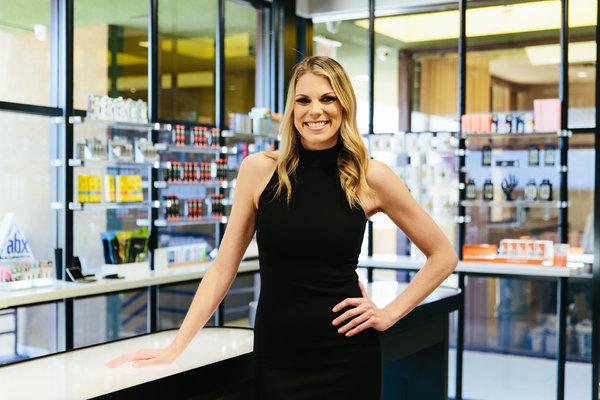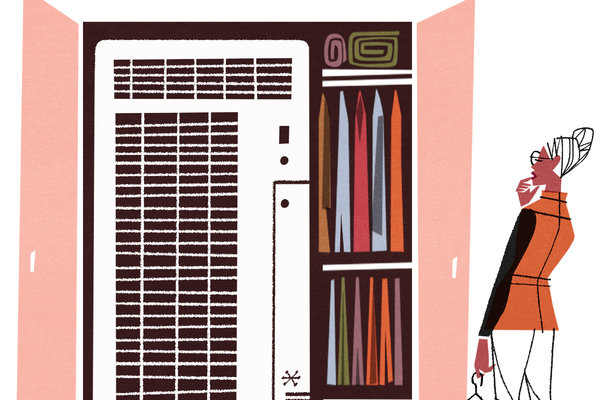When Brett Beldock, a Manhattan-based furniture designer, was growing up in the city in the early ’70s, she would buy “the grooviest jeans in the world” at the Different Drummer, a boutique whose advertising poster was designed by Peter Max, the psychedelic artist. Ms. Beldock’s new capsule collection of marijuana-themed wallpaper, titled Dispensary, recently put her in mind of that old store, but its look was certainly not modeled on the hippie emporiums of yore.
Instead, inspired by the comfortable Victorian parlor of a medical marijuana dispensary she visited in San Francisco, Ms. Beldock created designs based on antique botanical drawings — but the plant is pot. Two of the patterns, Botanical Weed and Botanical Ganja, use the sedate shades typical of Farrow & Ball paint colors; a third, Mary Jane, references the ornate foliage in the artist Kehinde Wiley’s portrait of President Obama.
“These dispensaries are popping up all over the country,” Ms. Beldock said. “Why wouldn’t I do wallpaper for these spaces that look like living rooms?”
With dozens of states having legalized marijuana for medicinal or recreational use, or both, in recent years, designers like Ms. Beldock are seizing the opportunity to define the look of a growing industry and lifestyle. And as the drug loses its outlaw, déclassé status, going from “weed” to a “flower,” the design around marijuana is similarly shedding its head shop past and becoming more elevated.
Some nouveau marijuana designs make winking reference to old-school pot imagery, like the ashtrays and vessels printed with red lips and leaves that Jonathan Adler created last year for the Manhattan flagship of Higher Standards, a retail shop. Sometimes it’s about treating pot in an unexpected way, as with Ms. Beldock’s old English specimen drawings. Often, it means creating an altogether fresh design vocabulary.
Whatever the case, being a pot smoker is not a requisite. As Mr. Adler told The New York Times last year, “I don’t smoke or do any drugs, but you can get a decorative dirty frisson.”
Megan Stone, the founder and principal of High Road Design Studio, who does consume cannabis, is a leading practitioner of a field she helped invent: dispensary design. In 2011, Ms. Stone was a college design student and a part-time “bud-tender” at a dispensary in Santa Ana, Calif., when her boss gave her a modest budget of $5,000 to improve the space.
She installed nice display cases, painted the walls and made other simple fixes. There was so much room for improvement that customers began telling her “they felt like they were shopping at the Tiffany’s of dispensaries,” Ms. Stone said.
She added: “This was still the era of bulletproof glass and bars on the windows. There are a ton of professional people that use cannabis every day, and we’re in this place where we’re a little embarrassed because we’re not hippies and stoners.”
Back then, the only thing Ms. Stone could find online pertaining to marijuana and design was an article about Sparc, a Bay Area dispensary designed by Larissa Sand that won an architecture award. “Dispensaries were a space that had never been touched by design,” Ms. Stone said.

Megan Stone’s specialty is designing marijuana dispensaries, like this Royal Highness store in Palm Desert, Calif.CreditLaura Austin for The New York Times
Her firm has designed about 50 dispensaries in 16 states. Every space is different, owing to the noncorporate, patchwork nature of the industry, but in all of Ms. Stone’s projects, she aims for a polished, handcrafted look. She brings in a millworker for custom cabinetry and is big on contrasting colors and textures.
While she avoids stoner clichés, Ms. Stone does try to “blow minds,” usually with an eye-popping design feature. For Maitri Medicinals, in Uniontown, Pa., she created a 14-foot-high lobby wall covered in historical documents like the Marihuana Tax Act of 1937 that she reprinted on hand-pressed paper. To dress up the ubiquitous A.T.M., Ms. Stone hung more than 1,400 colored ribbons from a wire-mesh frame to create a tunnel that customers walk through.
“It’s functional and provides privacy,” she said, “but it’s memorable and provides a living art piece in their showroom.”
Bruce E. Teitelbaum, the chief executive and founder of RPG, a design/build firm for brands and retailers, said he adhered to the same design principles for the medical marijuana provider Columbia Care, for which RPG created a dispensary in Manhattan in 2016, as he did for clients like Barnes & Noble College, which runs campus bookstores: “We followed the philosophy of good taste, good design, good customer navigation.”
Like Ms. Stone, Mr. Teitelbaum avoided showing up-close photos of gnarly buds, à la High Times, and instead kept any references to the product for sale artistic, and subtle. He installed terrariums with succulents and other potted plants.
“That was a touch to the natural quality, the growing quality,” Mr. Teitelbaum said. “It’s like going into a great bakery and understanding they must have a beautiful kitchen and beautiful process of baking bread when you just see the front end.”
The activity of marijuana smoking has always had its gear, and this too has gotten a design upgrade in recent years. Higher Standard sells pipe-cleaning products like finely milled rock salt and “ISO Pure” solvent in packaging that looks as if it came off-the-shelf at Sephora.
The company Apothecarry Brands specializes in “high quality organizational systems,” like a $300 airtight, odor-resistant, lockable home storage case.
“I kept my wine in a wine fridge and my high-end cannabis in a shoe box under the bed. It didn’t make sense,” said Whitney Beatty, the company’s chief executive.
Ms. Beatty said she designed the attractive wood case because she couldn’t find any on the market — at least none that spoke to her self-image as a successful businesswoman and mother. “I love tie-dye as much as the next person. But I’m living a Pottery Barn lifestyle. I do not need a stereotypical cannabis store item.”
Products like the Apothecarry Case point the way to the home as the next frontier of marijuana design. One can imagine herb humidors instead of wine cellars, dedicated smoking rooms instead of basement hide-outs for getting high. The walls of these spaces could be covered in Mary Jane, Ms. Beldock’s wallpaper. “Unfortunately, it’s not scratch and sniff,” she joked. “Then it would be a real success.”
But perhaps the true vanguard of marijuana design — and a sign of how subtly it will be incorporated into our everyday lives — can be found at the Desert Hot Springs Inn, in California’s Coachella Valley. The boutique hotel has become popular for its welcoming attitude toward cannabis.
John Thatcher, the manager, is “pushing 60” and of the generation that remembers lava lamps, beaded curtains, black light posters and all the hoary design once associated with smoking pot. At the hotel, he said, there is none of that stuff, because “the guests are not looking for that.”
Despite the smell of pot wafting through the inn’s six rooms, there isn’t a dedicated smoking lounge, either. Nor are there plans to create one. The Desert Hot Springs Inn looks like any other boutique hotel, the only difference being the guests can freely light up.
“We do have a big backyard area. A lot of people go out there,” Mr. Thatcher said, adding, “It’s a very mellow situation. My general philosophy with the hotel is I just let things flow.”










